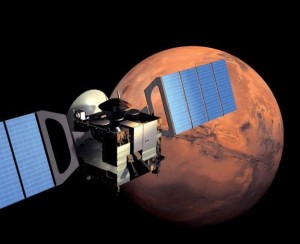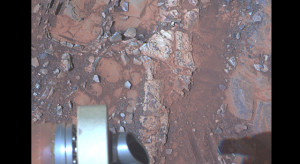by: Kathryn Sharp
 While the rovers Opportunity and Curiosity cruise the surface of Mars, three operating satellites orbit above, keeping a keen eye on the planet. In addition to documenting the surface of Mars with an unprecedented level of detail, these satellites continue to provide critical support for ground missions. They relay vital communications between the rovers and Earth, monitor surface weather, look for safe driving paths around large boulders, and identify points of interest for further study. Although they often work in tandem to support the rovers, each orbiter has made its own fundamental contributions to our understanding of the red planet.
While the rovers Opportunity and Curiosity cruise the surface of Mars, three operating satellites orbit above, keeping a keen eye on the planet. In addition to documenting the surface of Mars with an unprecedented level of detail, these satellites continue to provide critical support for ground missions. They relay vital communications between the rovers and Earth, monitor surface weather, look for safe driving paths around large boulders, and identify points of interest for further study. Although they often work in tandem to support the rovers, each orbiter has made its own fundamental contributions to our understanding of the red planet.
 The oldest of the three currently operational satellites orbiting Mars is the 2001 Mars Odyssey. Named as a tribute to science fiction writer Arthur C. Clarke’s beloved work “2001: A Space Odyssey,” Mars Odyssey has been plugging away for well over a decade in low Mars orbit and has set the record as the longest serving spacecraft orbiting a planet other than Earth. Early in its mission, Mars Odyssey surprised scientists by detecting levels of water ice in the Martian soil that far exceeded expectations. This discovery intensified interest in the history of water on Mars and what that history could mean for the possibility of life there. Though perhaps its most important science work is done, Mars Odyssey has been granted numerous mission extensions, primarily to serve as a telecommunications relay between rovers Opportunity and Curiosity and Earth.
The oldest of the three currently operational satellites orbiting Mars is the 2001 Mars Odyssey. Named as a tribute to science fiction writer Arthur C. Clarke’s beloved work “2001: A Space Odyssey,” Mars Odyssey has been plugging away for well over a decade in low Mars orbit and has set the record as the longest serving spacecraft orbiting a planet other than Earth. Early in its mission, Mars Odyssey surprised scientists by detecting levels of water ice in the Martian soil that far exceeded expectations. This discovery intensified interest in the history of water on Mars and what that history could mean for the possibility of life there. Though perhaps its most important science work is done, Mars Odyssey has been granted numerous mission extensions, primarily to serve as a telecommunications relay between rovers Opportunity and Curiosity and Earth.
In 2003, the European Space Agency launched its Mars Express orbiter in with the goal of further investigating the presence of water and looking for chemical indicators of life. Mars Express is equipped with a host of instruments to accomplish these goals, including: two spectrometers, sub-surface radar intended to look for and map out frozen water beneath Mars’ soil, and among others, the High Resolution Stereo Camera (HRSC) which can take high-resolution photos of large regions on the surface.
 In the past decade, Mars Express has made remarkable discoveries. In January of 2004, ESA announced that water ice had been discovered in the Southern polar ice cap using its infrared spectrometer OMEGA. This discovery confirmed the 2002 findings of Mars Odyssey, which noted large quantities of water ice locked in the soil. Later that year, a large plume of methane was detected in the atmosphere. Since methane deteriorates in the Martian atmosphere in only 400 years or so, scientists postulated that the source of the gas must be ongoing: either organic life or volcanic activity. In either case, this exciting finding indicates Mars is, or was, more active than previously thought. However, recent measurements by Curiosity detect no significant quantities of methane in the atmosphere, calling into question earlier hypotheses. The topic presents a puzzle that will be the focus of several future missions, including the ESA’s Trace Gas Orbiter, set for launch in 2016.
In the past decade, Mars Express has made remarkable discoveries. In January of 2004, ESA announced that water ice had been discovered in the Southern polar ice cap using its infrared spectrometer OMEGA. This discovery confirmed the 2002 findings of Mars Odyssey, which noted large quantities of water ice locked in the soil. Later that year, a large plume of methane was detected in the atmosphere. Since methane deteriorates in the Martian atmosphere in only 400 years or so, scientists postulated that the source of the gas must be ongoing: either organic life or volcanic activity. In either case, this exciting finding indicates Mars is, or was, more active than previously thought. However, recent measurements by Curiosity detect no significant quantities of methane in the atmosphere, calling into question earlier hypotheses. The topic presents a puzzle that will be the focus of several future missions, including the ESA’s Trace Gas Orbiter, set for launch in 2016.
The newest satellite to reach Mars, NASA’s Mars Reconnaissance Orbiter (MRO), carries a suite of state-of-the-art instruments intended to address many of the burning questions left unanswered from previous missions. The most compelling of these is whether or not water persisted on the surface of Mars long enough for organic life to arise. Answering this question continues to be one of the primary science goals of NASA’s entire Mars Exploration Program, and would likely be the focus of any manned mission in the future.
 Thankfully, Mars Reconnaissance Orbiter has been incredibly prolific, returning an unprecedented amount of data from Mars since its insertion into orbit in 2006. In 2013, NASA reported that the MRO has returned in total over 200 terabits of data: more than all other missions operating on the Deep Space Network and significantly more than all other previous Mars communications combined.
Thankfully, Mars Reconnaissance Orbiter has been incredibly prolific, returning an unprecedented amount of data from Mars since its insertion into orbit in 2006. In 2013, NASA reported that the MRO has returned in total over 200 terabits of data: more than all other missions operating on the Deep Space Network and significantly more than all other previous Mars communications combined.
The majority of this data has come in the form of high-resolution images from the HiRISE camera, which works in conjunction with other instruments aboard the MRO to help scientists understand in detail the dynamics of Martian geology. To do so, the CTX (Context Camera) takes large regional surveys around features of interest, after which HiRISE narrows in to take a close-up photo of that feature. Simultaneously, the onboard spectrometer CRISM analyzes the mineral composition of that same region. By compiling data from these three instruments, scientists can distinguish between sediment deposited by moving water, wind, or other geologic processes and begin to piece together a picture of Mars’ fascinating history.
 Not only are these images important for their scientific relevance, but they have also played a powerful role in engaging the public interest in Mars. Never before have we been able to see the surface of another planet in such striking detail. In these images, we are afforded more than a glimpse at a planet that is alive in many ways. Changing seasons, fresh impact craters, landslides, recurring flow-like features, and dunes shifting in the Martian winds, all witnessed from here on Earth. The HiRISE team has reached out to professionals, amateurs, and students with its HiWish Public Suggestion Page. HiWish is a tool that allows any interested citizen to log in and select a target where they think HiRISE should take an image. This is a fantastic opportunity for young scientists to engage with Mars and play a part in exploring its rich topography.
Not only are these images important for their scientific relevance, but they have also played a powerful role in engaging the public interest in Mars. Never before have we been able to see the surface of another planet in such striking detail. In these images, we are afforded more than a glimpse at a planet that is alive in many ways. Changing seasons, fresh impact craters, landslides, recurring flow-like features, and dunes shifting in the Martian winds, all witnessed from here on Earth. The HiRISE team has reached out to professionals, amateurs, and students with its HiWish Public Suggestion Page. HiWish is a tool that allows any interested citizen to log in and select a target where they think HiRISE should take an image. This is a fantastic opportunity for young scientists to engage with Mars and play a part in exploring its rich topography.
Each day, NASA and the ESA receive an enormous amount of data from the instruments aboard these three spacecraft, providing an invaluable link between the Earth and Mars. When humans finally arrive on the surface of Mars, it will be due in large part to the continued success of these three missions. We have sent them ahead of us to be our mapmakers: to chart safe passage, to help us find resources vital for our survival, and to unlock the secrets of a planet that does not readily tip its hand.
[Images: NASA, JPL, ESA, JPL, JPL]












